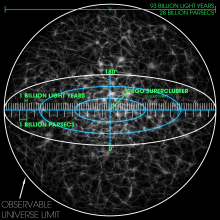Beyond View [1]
Our “universe” is only part of the universe — all of matter and energy, space and time. That’s because our view of the universe is limited. We see only a tiny sliver of it — a result of the age of the universe, the expansion of the universe, and the speed of light.
The fraction we see is known as the observable universe. And from what we see, it’s all the same. Everywhere we look, there’s the same mixture of galaxies and empty space, of stars and gas clouds. And everything seems to follow the same laws of physics.
But we don’t know what’s happening in the rest of the universe — everything beyond the “cosmic horizon” — the limit of our viewing range.
Logic suggests that everything beyond that horizon is just like everything in the observable universe. There’s no reason that the “bubble” of the universe we inhabit should be any different from the universe as a whole. But we just don’t know for sure — and we probably never will.
Scientists can try to draw some inferences, though. If they observe a galaxy cluster that’s 10 billion light-years away, for example, it has its own observable universe. Some of it overlaps our own, but some extends far outside it. If the cluster is being pulled toward the region we can’t see, then scientists might conclude that it’s been dragged by the gravity of something big and heavy — perhaps a giant galaxy cluster far outside the observable universe — something we’ll never see.
Script by Damond Benningfield
Keywords:
- Cosmology [3]
- Size of the Universe [4]


